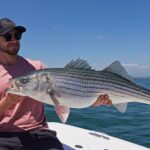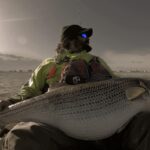
We Stand on the Shoulders of Giants.
Photo Credit: Guiding Flow TV The fishing industry has lost an icon. The family and
Capt John McMurray
Menhaden and striped bass top the agenda
The Atlantic States Marine Fisheries Commission met last week to consider, amongst other things, several items relating to menhaden and striped bass.
First, let’s cover menhaden as of course the two are related.
Without getting into too much detail, this was a watershed event. Prior to the August meeting, menhaden were managed in a single-species context – how many can we take out of the stock without causing it to decline, but with no real consideration of predators’ needs. Those of us who spend time on the water well understand menhaden’s critical role in the marine ecosystem. Just about everything eats them. But what’s particularly noteworthy is their relationship to striped bass.
After literally decades of advocacy by the recreational fishing and ENGO communities, not to mention several years of hard work by the Commission’s technical folks, the management of the menhaden stock should now be based on its interaction with predators (striped bass in particular) rather than just on sustainable harvest.
Last week, the Menhaden Board met to set the 2021-2022 “Total Allowable Catch” (TAC) for menhaden. The new quota would supposedly be based on the new ERPs, and should technically have no more than a 50% probability of exceeding the “ERP target fishing mortality” (which is generally accepted as the minimum management standard).
At the August meeting, the Board tasked the Atlantic Menhaden Technical Committee (TC) with developing projections/quota options that had a 25 to 60% probability of exceeding that target. Staff did those projections, and it looked like the quota for the last several years had more than a 60% chance of exceeding the ERP target.
If the board were to choose a quota that had a 50% probability of exceeding the target, it would have translated to an 18% reduction to the prior years’ quota.
Clearly industry wanted the status-quo quota, and gave a few compelling reasons, and one or two not-so compelling ones, in support of its position. One of the more ridiculous ones was that because stripers were depleted (overfished) then we didn’t need to leave all these menhaden in the water. Not only is it pretty clear to most that a healthy and abundant menhaden population will help striped bass rebuild, that argument disregards the fact that the focus on striped bass in the ERP is only because striped bass were the most sensitive to the model. In other words, if there’s enough for striped bass than there’s probably enough for other predators.
But there were other arguments that gained traction – such a steep reduction (18%) would be too hard on industry, landings were down in 2020 because of the COVID pandemic, status quo TAC would have zero chance of exceeding the ERP target threshold, etc.
In the end, in a not-so-close vote, the Board approved a quota that would result in a 10% reduction and have a 58% chance of exceeding in the ERP target in the first year and a 52% chance in the following year.
Now let me editorialize for a minute. On its face, this is not terrible. The board could have capitulated to industry and disregarded the ERP all together, choosing the status quo quota. I mean, you have to ask yourself if we were lucky to get a 10% reduction. But, while that sort of meeting-in-the-middle seems reasonable, it’s really not. Because it pretty much shows that the Commission can do whatever it wants, and to hell with the best available science.
The truth is the board agreed unanimously to adopt ERPs in Aug with the support of scientists, academics, anglers, conservationists – pretty much everyone. But while the board said it would manage menhaden for their role in the ecosystem, well, when it comes down to actually having to make a decision to constrain landings – one that will have at least a 50% change of achieving the intent–well, no they’re not really going to do that.
It’s the same old stuff this management body has been doing for decades. It doesn’t make difficult decisions that might impact industry, even when the science is clear that it should. And in the end, it almost always capitulates, at least to some extent, to special interests (the great majority of public comment supported a quota that had less than a 50% probability of exceeding the target).
The reality is that a 50% probability of success should have been the bare minimum, given all uncertainties here, particularly given recent status of striped bass, bluefish, weakfish, and Atlantic herring (not in spite of their status). And the model only includes a handful of species that feed on/depend on menhaden, it doesn’t account for other species such as whales, which are probably the biggest consumers of menhaden in the ocean.
I mean really, the board should have been considering something even more conservative than 50% probability of exceeding the fishing mortality target. The hard truth is that any quota that has a greater than 50% probability of exceeding the target is inconsistent with the ERPs’ objective, and should be seen as unacceptable in the public’s eyes.
All that said, it’s still a step forward in ecosystem-based management I suppose. So, we’ll move on and hope for the best. But we’d be lying if we said that we liked this decision. It’s a clear example of how management bodies with no mandate to prevent overfishing will allow it 9 out of 10 times. And it’s very clearly why just about everything the commission manages is in bad shape.

Striped Bass
The Commission’s Striped Bass Board met on Wednesday, Oct 21, primarily to discuss a draft “Public Information Document” (PID) for Amendment 7 to the Atlantic Striped Bass Management plan, but also to discuss discard mortality and state circle hook mandate compliance. Regarding the latter, not much to say here. They were relatively short discussions.
As part of Addendum VI, states must mandate circle hooks for all bait fishing in their state by 2021. The state of Massachusetts asked for a circle hook requirement exemption for the state’s charter/party boat fleet without any real justification for such an exemption. The board ended up shooting that down pretty quickly. Other requested exemptions included exempting tube-and-worm rigs in Maine and any baits attached to trolled, cast, or jigged lures in Massachusetts. Those were shot down too, as the board felt they opened doors to all types of bait fishing.
Regarding the recreational discard mortality discussion, of course recreational discards are high, as they are high in any fishery that is valued primarily as a sport fishery. It is still not clear on what the long-term goal of doing more analysis is here. Yes, we need to and we have mandated gear requirements (e.g., circle hooks in bait fisheries) that will reduce release mortality where it can be reduced, and yes, there should be outreach on better handling techniques, but overall, it is foolish to think we think we can effectively address high discards in this fishery because people will ALWAYS practice catch and release, whether it’s voluntary or size-limit driven. And I’m pretty sure the public won’t be okay with time and area closures. Discards will not simply go away in this fishery. Regardless, it’ll be rehashed to death with no real solution. A 9% discard mortality rate isn’t terribly high in my opinion, and it’s simply part of the fishery and should be accepted as such. One thing is crystal clear. Turning discards/releases into harvest will drive fishing mortality higher by orders of magnitude, and that certainly isn’t a solution, although some still seem to be hanging onto it.
Lastly, the Board went over the draft PID and made some revisions. There were enough revisions that the board felt that such revisions needed to be better articulated in the document before it could go out to the public. And so, the Board will take another look at its meeting in February before approving it for public comment. We will likely have public hearings on Amendment 7 next spring.
We talked about this in out last meeting summary, but a few things to watch here.
The first is the revisiting of the Goals and Objectives of the management plan. This opens the door to completely alter how we manage striped bass, and if we aren’t VERY vocal about our interests (i.e. abundance drives participation) during the public comment period things could go bad quickly. We also need to keep a close eye on the reference point and management trigger comments. These could seriously lower the bar on what a healthy stock looks like and how the board reacts to problems in the fishery.
There’s also a few opportunities to really improve things. For one, we have a real opportunity to improve on how the Commission does Conservation Equivalency (CE) – allowing states to craft their own equivalent (on paper) regulations. Some states clearly use it to liberalize regulations. And for sure we can clarify some parameters around CE regulations and of course ask for some state accountability when they fail, which they often do.
More to come on all of this, so please stay tuned.

Photo Credit: Guiding Flow TV The fishing industry has lost an icon. The family and

Earlier this summer, the Jack Project took another big step forward. On the waters of

Fisheries management along the Atlantic coast is a mess, and the Atlantic States Marine Fisheries

Striped bass anglers from Maine to Virginia have spent years navigating shifting regulations meant to
We rely on our members and donations to keep fighting for a sustainable tomorrow in marine conservation.
GIVE THE GIFT OF FISHERIES CONSERVATION THIS HOLIDAY SEASON. SHOP ASGA GOODS THAT FUND FISHERIES RESEARCH & ADVOCACY CAMPAIGNS
JOIN ASGA IN CALLING FOR CRITICAL MANAGEMENT ACTION AFTER YEARS OF SPAWN FAILURES & POOR MANAGEMENT.
By using this website, you agree to our use of cookies. We use cookies to provide you with a great experience and to help our website run effectively. To learn more, please review our privacy policy.
4 Responses
John,
Thanks as always for your hard work here, i am hoping that positive, conservation minded public comments will help sway the managers into a more proactive stance towards rebuilding both stocks
Curious to know how they will handle these sessions in our current environment, given the challenges around public gatherings and perhaps even the proclivity of certain stakeholders tolerance towards science based health guidelines.
Kerry,
As of now, the meetings will be held virtually which should lend itself to greater stakeholder input.
Thank you for the update of what seems to be a complex issue. Thanks for all your input on behalf of sportsmen.